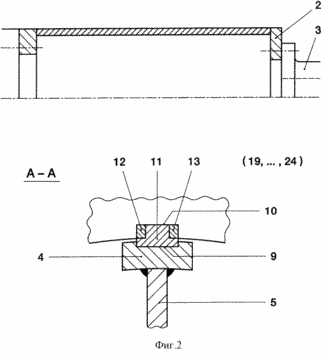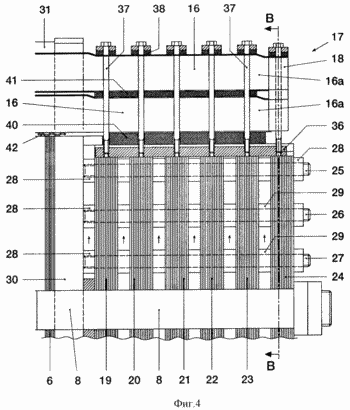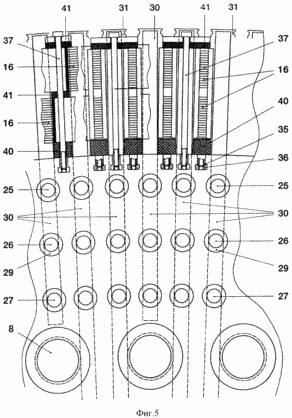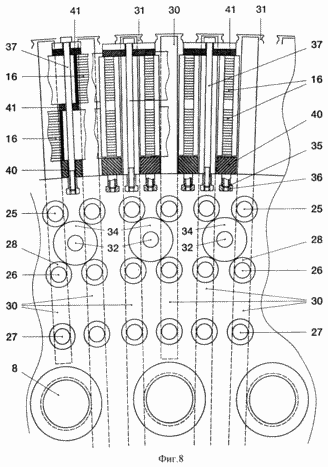| section Home
Production, Amateur Radio amateur Model aircraft, rocket- Useful, entertaining |
Stealth master
Electronics Physics Technologies invention |
space Mystery
Earth Mysteries Secrets of the Ocean Stealth section Map |
|
| Use of material is permitted for reference (for websites - hyperlinks) | |||
Navigation: => |
Home / Products Patents / In the section of the catalog / back / |
|
INVENTION
Russian Federation Patent RU2174278
![]()
ROTOR ELECTRIC MACHINE
Name of the inventor: Joseph SHVANDYA (AT); FEGELE Hans (CH)
The name of the patentee: Asea Brown Boveri AG (CH)
Patent Attorney: Silaeva Alla
Address for correspondence: 103735, Moscow, ul. Ilinka, 5/2 "Soyuzpatent" Silaeva AA
Starting date of the patent: 1996.04.02
The invention relates to electrical engineering, and relates to the manufacture of rotors of electrical machines. The technical result from the use of this invention is to provide a simple manufacturing of the rotors, in particular motor-generators for storage hydroelectric without expensive auxiliary mounting means, but also in the creation of a support head parts of the rotor windings withstand all loads occurring during operation, and limiting the possibility of their cooling. The inventive rotor is assembled from sheet plate (7). The body (6) is located on the hub of the rotor and retained by axially extending tie bolts. The ends (16a) of the coil forming the frontal portion (17) is fixed by means of fixing means having a support ring, from the effects of centrifugal forces. According to the invention the body on the end plates (6) of the rotor are arranged push pins (30) and the support ring consists of at least two spaced apart axially rings (19 - 24), which rest on the inner circumference of the hub. Thus rings close to the axis of the rotor body portion (6) of the rotor together with push fingers (30) are tightened by means of extending axially through the body (6) of the rotor of the first coupling bolt (8), and away from the axis of the body portion (6 ) provided the second rotor coupling bolts (25 - 27) extending only through the rings (19 - 24) in the axial direction. Third tension bolts (37) passing through the frontal portion of the winding in the radial direction, at least on the outer circumference of the impact on the outermost ring (19 - 24), when viewed in the axial direction.
DESCRIPTION OF THE INVENTION
The invention relates to a rotor of the electric machine, particularly motor-generator for a pumped storage power plant, with arranged on a hub fixed in the axial and circumferential direction of the rotor body, which is assembled from sheet metal plate and is held by means of axially extending tie rods, with slots for external rotor body perimeter, in which is laid the rotor winding and is held there by centrifugal force, and extending in the axial direction of the rotor body forming the front part of the ends of the windings are fixed via having a support ring fasteners from the centrifugal force, a support ring which is both the pressure plate to the rotor body.
The invention is based on the prior art, which implies, for example, from the book. Wiedemann / Kellenberger "Design of electric machines", Springer-Verlag Publishers, Berlin, Heidelberg, New York, 1967, pages 377-380, in particular Fig. 375 p. 378.
In production-technical reasons (optimal efficiency, the load regulation in the pump mode, the stability of the network), there is a growing demand for the motor-generators with variable speed mainly for pumped storage power plants. Such machines are performed by cost considerations in most cases in the form of asynchronous machines with a wound rotor double-energized.
In such machines the rotor and, in particular, the frontal part of the rotor winding are exposed to extreme mechanical and thermal loads. Usually asynchronous machines Propping end winding from the effects of centrifugal force by means of bands of pre-tensioned steel wire in combination with a massive solid steel ring, which is simultaneously the pressure ring sheet rotor (Wed said source, Fig. 375A p. 378 ). The limits of this embodiment defined costly mounting aids conveying rotor dimensions and limited weight. For rotors for hydro generators with large size assembly must be carried out directly on-site at the plant. In addition to this large massive steel rings prevent venting end winding, thereby cooling it.
The basis of the invention is to provide a rotor of the electric machine, in particular, the motor-generator for pumped storage power plants, which can be easily manufactured without expensive auxiliary assembly means, and which is capable of supporting all occurring during the operation of the load bearing head portions of the winding, which does not limit them cooling.
According to the invention this object is achieved due to the fact that the end plates of the rotor body positioned push fingers that support ring consists of at least two spaced apart axially rings that an inner circumference based on the hub, the rings close to axis portion of the rotor body together with push fingers tightened via passing axially through the first coupling bolt rotor body at the remote from the axis portion second tension bolts are provided which pass through said ring in the axial direction and tightening the ring in the axial direction, provided the third clamping bolts passing through the frontal portion of the winding in the radial direction, which at least act on the outer circumference of the outermost ring, viewed in the axial direction.
According to a first improved embodiment of the subject invention, on the outer circumference of the rings provides a large number of divided circumferentially extending axially spaced along one line semi grooves in which are respectively inserted fitted extending radially threaded holes line, a threaded hole which screwed into said third coupling bolts. This gives easy to manufacture and reliable radial support.
Preferably, directly adjacent to push the ring finger is removed from them, and the second tightening bolts are at the end of the part of the rotor retaining nut body, the height of which corresponds to said distance. This creates additional compression pressure exerted on the push fingers, which can be improved by the fact that, when viewed in the radial direction are provided at least two second coupling bolts, and the height of nuts located near the axis portion is less than remote from axis area. Thus, when the ring system is experiencing pretensioning seal. Effort seal acts as a pressing force to push the fingers or on the center of gravity of the rotor ring.
Under certain conditions, it may happen that the ring system would be too small (effective) cross-section, to independently act as a coupling element. Therefore, an improved embodiment of the invention provides for the additional tension section remote from the axis fourth tension bolts presence of which extend axially through both the ring and the rotor body through, but does not push through the fingers. These fourth tension bolts are electrically insulated both relative to the rotor body and relatively rings.
Ring system with advantage fixed to the hub in the axial and circumferential directions in the same manner as that of the rotor body.
The dimensions of the rotor body and the support ring systems are selected such that both elements extend uniformly in operation in the radial direction. Perhaps there is a small difference in expansion between the rotor ring and the ring system may be perceived preferably through investing its undulating springs from an insulating material, which are inserted into the bottom of the grooves of the rotor windings.
Brief Description of the drawings below, in which:
 |
 |
FIG. 1 - a longitudinal section of a simplified motor-generator as a rotor. FIG. 2 - cross-sectional view of the hub seat and the compound machine rotor body in accordance with FIG. 1 along line A-A.
 |
 |
FIG. 3 - a perspective view of a junction according to FIG. FIG. 4 - a longitudinal section of the right end of the rotor machine according to FIG. 1 on an enlarged scale.
 |
 |
FIG. 5 - cross section and the end winding supports relating thereto in accordance with FIG. 4 along line B - B. Fig. 6 - a top view of the front of the winding machine.
 |
 |
FIG. 7 - a longitudinal section of the right end of the rotor similarly to FIG. 4 additional isolated coupling bolt on the remote from the axis of the plot. FG. 8 - cross-section and the winding overhang support relating thereto in accordance with FIG. 7 along the line C - C
FIG. 1 The drawings are highly schematic form a motor-generator rotor. It comprises a hub 1, with the interior of the rotor hub 2, which is flanged to a shaft not shown in the drawing, a hydraulic turbine, and an outer portion of the hub, which consists of a large number of uniformly circumferentially spaced crossbars and for brevity called the hub, and reference numeral 4. Both hub part connected to each other by means of brackets 5, preferably struts, the ends of which are closed with a covering plate 5A. This covering plate does not reach the inside of the hub. During operation of the machine based on air venting action is sucked into the space between the struts and the cover plates 5 and 5a flows through fixed on the outer circumference of the hub body 4 of the rotor 6. It consists of a sheet metal plates 7, which are pressed through the body passing through the rotor coupling bolts 6 (see., e.g., FIG. 4, position 8). In this case the rotor body 6 is divided into spaced apart in the axial direction of the partial bodies consist of sheet steel (FIG. 1 only labeled) between which remain free radially extending cooling slots, through which cooling air can flow outwardly in air gap of the machine.
Mounting of the rotor on the hub body 4, 6 is carried out in a known manner via a system of wedges, as is clearly shown in FIG. 2 and 3. Outside the hub 4 are provided axially extending first grooves 9 of rectangular cross section, opposite the internal periphery of the rotor body 6 are arranged grooves 10 and rectangular cross-section. The first groove is inserted a wedge P T shaped cross section. By means of driven wedges 12, 13 which are complementary in the wedge driven into a state 11 to form a rectangular parallelepiped body of the rotor 6 is fixed to the hub 4 in the circumferential direction. The rectangular shape is provided a system of wedges that can move relative to the radial direction, whether due to thermal effects and / or centrifugal force, between the hub body 4 and the rotor 6. Fixation rotor body 6 at one end of the hub 4 by means of the bead 14, at the other end of the hub by inserting the outside perimeter of the hub 4 and fixed axially opposite plates 15 which are distributed over the circumference of the hub 4.
In the case of the example on the outer circumference of the rotor body situated in the grooves 6 bilayer rotor winding 16 and is retained therein by means of wedges mortise. Exiting the axial direction of the rotor body forming the frontal portion 17 the ends 16a of the winding in a known manner is electrically and mechanically connected by a hinge 18, the hinge 18 connects the end protruding from the slot conductors of the lower layer of the winding with the end protruding from the remote groove wires upper winding layer (cf. . Fig. 6). This design and the wiring in the end winding, and can be referred to prior art, which is not a subject of the invention.
As is clear from an examination of the frontal part of the winding 17 (shown only in part), be sure to need to strengthen the frontal part of the winding with respect to centrifugal force effects.
Thus, as already described in the introductory part, the bandages in combination with massive support rings which simultaneously operate and function of the pressure plate, not taken into account, the present invention provides for exercise additional support via ring system which consists of several individual rings 19 - 24 and below this system is called bearing ring. The rings 19 - 24 are gathered on the type of rotor body made of sheet steel sigmente thickness of 2 to 6 mm. In this case made of sheet metal segments of one layer are offset circumferentially relative to adjacent layer segments. In the case of the exemplary embodiment six rings via prestressed tie rods 25, 26, 27 and nuts 28 are compressed into a single support ring. As is clear from FIG. 5, coupling bolts 25-27 are evenly distributed around the circumference. The intermediate members 29 in the form of pipe lengths provide gaps between the rings 19 and 20, 20 and 21, 21 and 22, 22 and 23, a 23 and 24. Instead, intermediate and pipes can be used and radially extending intermediate plates through which the three coupling bolts. Thus, cooling air flows from the hub to the front part 17 of the winding.
The support ring is integrally pushed over the hub 4 and the hub 4 is fixed in the circumferential and axial directions in the same manner as was described in connection with the rotor fastening body 6 through FIG. 2 and 3.
Now that the support ring could perform its first function (pressing body rotor 6) at the end faces of the last sheet of the body case are used extending radially push the fingers 30, for example welded to it. These push-in fingers 30 extend remote from the axis of the rotor body zone between adjacent winding wires 16 almost to the outer end of teeth 31 slots. In situated near the axis they plot to end with a seal tie bolts 8 or pass through them to the hub (cp. Fig. 5). Now with the rotor pass through the entire body 6 the clamping bolt 8 presses against the support ring 30 and the pressure fingers, and thus to the body of the rotor 6. Clamping force in the area located near the axis for this is quite enough.
To ensure that in the zone remote from the axis, that in the zone of clamping screws 26 and particularly in the zone most remote radial clamping bolt 25 could provide a sufficient effect of compression force on the body 6 of the rotor, an improved embodiment of the invention provides to choose the height of which are located at different radial level nut 28, clamping bolts 25, 26 and 27 so that the closer to the outer side of the nut were higher than the inner surface located radially nut. When using nuts same height invention recommends the use of different lining (Fig. 5, clearly not shown). Support ring strapped in a certain way with the help of the clamping screws 25 - 27. When the contraction via tie rods. 8 is ensured by its seal. The sealing force acts as a pressing force to push the fingers 30 or the surface of the rotor center of gravity of the body.
If it turns so that one support ring is not enough to provide a sufficient pressing force placed on the radially outward portions of the push fingers, for example, if it has an active cross section is too small, then in accordance with FIG. 7 and 8, a fourth tension bolts may be provided 32. They pass through both the support ring, ie, six rings 19-24 and the rotor body, but does not push through the fingers 30. These additional pinch bolts 32 fitted along the full length of the rod insulation 33 and fitting with the front face of the support ring through a pad of insulating plates 34. The other structures correspond to that which is shown in FIG. 4 and 5.
Along with the function of the pressure rings or pressure plates of the rotor body bearing ring in the form consisting of spaced apart rings 19 - 24 ring system performs the function of the end winding support. For this purpose, the outer circumference of the rings 19 - 24 are provided evenly spaced semi-T-shaped slots 35 which are aligned in one line in the axial direction. These grooves 35 inserted into line 36. In this case, threaded holes are located in the zone of the rings 19-24. The threaded holes 36 lines radially outwardly screwed coupling bolts 37, made in the form of studs to insulating spacers 38. The studs pass through the frontal portion 17 of the winding. The location and distribution of the pins 37 is most clearly evident from FIG. 4 in conjunction with FIG. 6 which is a simplified frontal reamer part 17 of the winding. FIG. 6 shows that the studs 37 pass through the resulting winding structure diamond-shaped openings 39 in the front portion 17 of the winding. They may, but need not, be provided with insulation at the shaft portion. Gaskets 40 and 41 of insulating material, for example of reinforced fiberglass synthetic resin between the seal rulers 36 and lower wires of the winding or between the lower and upper wire windings allow uniform pressure distribution on the wire 16 of the winding and a specific coupler frontal portion 17 of the winding to the ring system 19 - 24, which can withstand all operational loads without significantly impeding the flow of cooling air through the front part of the winding 17.
The dimensions of the rotor body and the support ring 6 19 - 24 are selected so that the two elements are expanded uniformly radially. Possibly occurring small expansion difference between the rotor body and the support ring b can be seen the elastic members of an insulating material, such as undulating springs 42 of glass fiber reinforced synthetic material, which are inserted into winding slots in the bottom 16.
CLAIM
1. The rotor of the electric machine, in particular a motor-generator for power gidroakkumulyatornyh, disposed on a hub (1) body (6) of the rotor, which is assembled from sheet metal plates (7) and restrained by the axially extending tie bolts, with slots for external rotor body perimeter, in which is stacked winding (16) of the rotor and is held there by centrifugal force, and extending in the axial direction of the rotor body forming the frontal portion (17) the ends (16a) of the winding are fixed by means having a support ring fasteners from the centrifugal force, a support ring which holds simultaneously a push rotor plate, characterized in that on the end of the body sheets (6) of the rotor are arranged push pins (30), wherein the support ring comprises at least two spaced apart axially rings (19-24), which rely on the inner circumference of the hub (1), the rings close to the axis of the body portion (6) of the rotor together with push fingers (30) are tightened by means of extending axially through the body (6) of the first rotor coupling bolt (8) and the remote station from the axis second tension bolts are provided (25-27) which pass only through the rings (19-24) in the axial direction and tightening the ring in axial direction being provided third tension bolts (37 ) passing through the frontal portion of the winding in the radial direction, which at least act on the outer circumference of the outermost ring (19-24), when viewed in the axial direction.
2. Rotor according to claim 1, characterized in that on the outer circumference of all the rings (19-24) provides a large number of circumferentially spaced, axially extending, spaced along one line semi-grooves (35) in which are respectively inserted fitted extending radial line threaded holes (36) in which threaded holes are screwed third tension bolts (37).
3. Rotor according to claim 1 or 2, characterized in that directly adjacent to the push fingers (30) ring (19) is removed from them and this gap is filled exactly intermediate element, preferably associated with the second tie bolts (25-27) for end of the rotor body by a nut (28), the height of which corresponds to said gap, serving as the intermediate member.
4. Rotor according to claim 3, characterized in that, when viewed in the radial direction are provided at least two second coupling bolts (25-27) and to provide pre-tightening height of the intermediate elements, preferably nuts height (28) located on the near the lower portion than remote from the axis portion.
5. Rotor according to claim 3 or 4, wherein the fourth tension bolts (32) are provided for further tightening of the axis on the remote site, which extend axially through both rings (19-24) and through the body (6 ) of the rotor, but does not push through the fingers (30), the fourth tension bolts (32) are electrically insulated both relative to the rotor body and the relative rings (19-24).
6. Rotor according to one of claims 1 - 5, characterized in that the rings (19-24) are fixed on the hub (4) in the axial and circumferential directions.
7. Rotor according to one of claims 1 - 6, characterized in that between the winding (16) of the rotor and the bottom of the grooves embedded elastic members (42) of insulating material.
print version
Publication date 12.01.2007gg




Comments
Commenting, keep in mind that the content and the tone of your messages can hurt the feelings of real people, show respect and tolerance to his interlocutors, even if you do not share their opinion, your behavior in terms of freedom of speech and anonymity offered by the Internet, is changing not only virtual, but real world. All comments are hidden from the index, spam control.